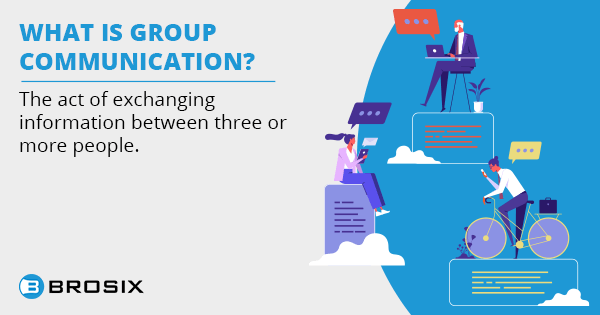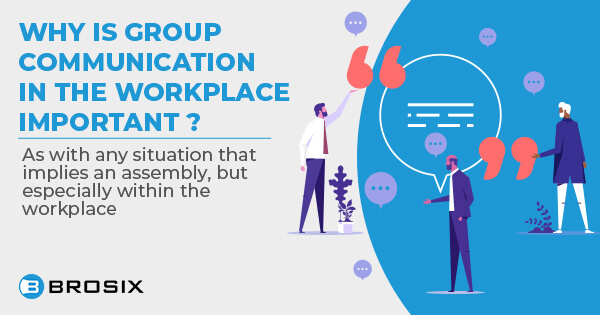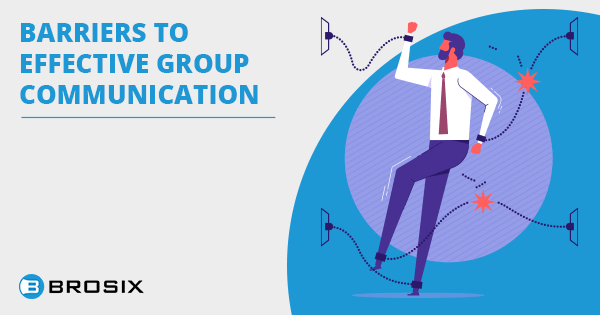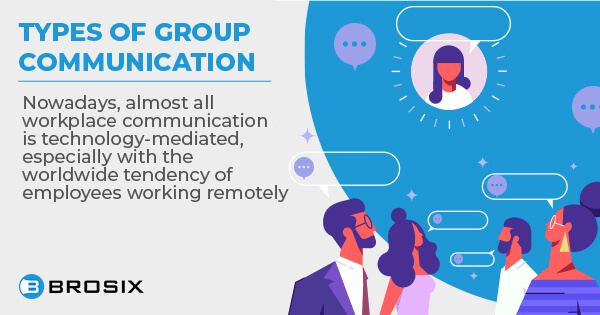In our fast-paced modern work culture, adaptability is paramount. It has proven to be one of the most important pillars that supports a business and leads it toward growth.
Developing effective communication procedures is equally important for a company, being a key factor that directly influences a company’s adaptability.
Successful employee and inter-departmental communication is what transforms a business into a well-oiled machine and makes it run as smoothly as possible.
Clearly defined roles and responsibilities for a project facilitate small group communication, which is essential to keeping track of the project’s status and meeting deadlines.
It’s imperative to communicate effectively nowadays.
For example, did you know that, according to the latest workplace communication statistics, 97% of employees say communication impacts their task efficiency daily?
Every company is likely to face communication challenges to some degree at some point along the way, especially now, given the growing popularity of remote work.
This has probably left managers wondering what can be done to facilitate group communication and collaboration to improve overall productivity.
Fortunately, this complete guide to group communication is packed with helpful tips.
What Is Group Communication?
Group communication is the act of exchanging information between three or more people.
Be it within small or large teams, group communication in a business environment is the ultimate driver of innovative ideas that can turn into fantastic opportunities.
Group communication is the core of every company, as it has the power to solve issues and conflicts within a group. Moreover, it is the crux of brainstorming sessions, team meetings, and any other type of business initiative undertaken for a company’s welfare.
Why Is Group Communication in the Workplace Important?
As with any situation that implies an assembly, but especially within the workplace, the importance of group communication is undeniable.
If we were to narrow down the top three most significant benefits of group communication, the shortlist would be:
- Transparency regarding goals and expectations
- Improved conflict management
- Feedback facilitation
Good communication also requires group members to be honest and open to different perspectives. Equally, diplomacy is always necessary.
Teammates who frequently and effectively communicate are more likely to develop trust, ultimately sparking closer relationships between each other.
Relationships based on trust lead to more fruitful outcomes, like fewer conflicts, for example, and long-term stability.
Barriers to Effective Group Communication
Depending on the group size, potential cultural differences, or the setting in which it takes place, different barriers can block constructive group communication.
When working toward improving group communication in the workplace, consider the most common communication challenges and think of actionable ways to overcome them.
- Poor internet connection: This communication barrier is particularly pertinent to remote work. A poor internet connection causes call interruptions and delayed messages. It is probably the most frequent communication challenge in today’s workplace and, unfortunately, the most unpredictable to control.
- Perceptual barriers: Each group member’s unique perspective and understanding of the world impacts how messages are perceived and acted upon. An introvert, for example, might dread client communication tasks more than an extrovert.
- Emotional barriers: The emotional states among group members also significantly influence group communication. Various emotions can affect how team members formulate their arguments and how they interpret their colleagues’ messages. Feelings of anger, distrust, and so on can alter the group communication dynamic.
- Interpersonal barriers: Group communication is also affected by people’s personal perceptions of themselves. Let’s go back to a previous example: an extrovert is likely to communicate quite differently from an introvert.
- Cultural barriers: Among the most common cultural barriers leading to miscommunication are assumptions and stereotypes. As the number of members with diverse backgrounds increases, the need to improve cross-cultural communication becomes a new communication challenge. If overlooked, these cultural barriers can even raise internal communication crises within businesses.
- Language barriers: The reason language barriers are a different category than cultural barriers is that they do not only refer to translation misunderstandings. Language barriers can also occur when all group members understand and speak the same language. Technical terminology or industry-specific jargon, for example, can also cause confusion and misunderstandings.
Types of Group Communication
Nowadays, almost all workplace communication is technology-mediated, especially with the worldwide tendency of employees working remotely.
However, depending on the topics discussed in a meeting, different settings may be more effective for productive group communication.
Virtual group communication
As said earlier, this type of communication in a group setting is increasingly popular. Depending on the team’s needs, they can use messages, audio, or video calls for effective team communication in real time.
In an attempt to facilitate group communication, companies put a series of technological resources at their employees’ disposal.
For many companies, finding the right communication tool to support group communication, especially for larger teams, raises challenges.
Non-virtual group communication
Remote work is great; we all know that. However, there are still situations when face-to-face interactions are preferable and necessary in order to get the most out of group communication.
Integrating a new hire into a team is a good example of such a case.
A new employee’s acclimation may be easier if the whole group gathers and works within the same physical workplace initially. That could be due to the immediate assistance available thanks to having colleagues in close proximity.
Similarly, team cohesion is built on experiences shared.
Besides more formal group gatherings, such as business meetings, slightly less formal ones are more likely to create stronger bonds between group members.
Lunches shared together or regular team building are very important activities that can facilitate positive group communication within the workplace.
Verbal and non-verbal group communication
To communicate effectively, team members should be considerate of both verbal and non-verbal cues.
In all environments, leading by example and showing mutual respect for every member’s gender, religion, nationality, and so on, is the foundation of effective communication.
As for non-verbal communication cues, these can reveal a lot about a group’s overall communication and dynamics.
Body language, for example, heavily influences how communication is received and perceived by a group. Therefore, keep this in mind when engaging with your team. Try to use open body language, which will encourage receptiveness and a positive atmosphere.
Channels for Group Communication
To be transparent from the beginning, there are too many types of communication channels available to choose from. The choice of a communication platform should be based on group dynamics and needs.
Some of the most popular group communication channels these days are, besides in-person communication conference calls and team chats.
Conference calls are a great means of communication since they allow team members to exchange ideas and express concerns in real time and (virtually) face to face. This time-effective channel for group communication can help solve any current issues.
Team chats, however, may prove quite effective for discussing information that group members may need to revisit frequently.
In addition, a great advantage of messages is that they are not that time-sensitive.
Therefore, team messages can be used to share less important updates, allowing employees to focus on their ongoing tasks.
Tip: When choosing a communication tool for your team, ensure it enables as many features as possible!
Brosix, for example, incorporates numerous group communication features that can improve work team efficiency, from team chat to voice and video calls, just to name a few.
Examples of Effective Group Communication
Some group communication examples that are likely to increase team collaboration in the long run include:
- Team buildings events
- Hackathons
- Training sessions, seminars, and workshops
Team building events are usually more focused on enhancing interpersonal relationships through fun and non-work-related exercises.
Recreational activities like board games or other problem-solving quests can allow group members to get to know each other better.
Being together in a relaxed atmosphere, where they can talk about their passions and more personal matters, may encourage team members to open up more. Ultimately, this can contribute to forging deeper bonds between them, so the group may become cohesive and supportive.
Training sessions and different workshops are not only knowledge-sharing opportunities but also some of the best platforms for employees to highlight issues they’re facing.
Learning and a relaxed environment are excellent catalysts for productive group team communication.
How to Improve Group Communication
Luckily, group communication within the workplace can be improved through a series of easy-to-implement and cost-effective ways.
To help employees develop stronger group communication skills, managers must focus on implementing a couple of incentives needed for effective group communication, such as:
- Cultivating transparent communication
- Leading by example
- Using the right communication channels
- Assess the communication styles of team members
- Establishing individual roles
Let’s dive deeper into specific group communication techniques to enable effective interactions in the workplace:
Encourage open discussions
A company aiming to foster efficient group communication should regularly gather its teams. Openly discussing important aspects relating to their work and position within the organization is key.
This is especially important before taking on new projects or when group decision making is required.
Every member of the group feels more empowered to express their ideas and opinions with other participants when communication is encouraged.
Open group discussions and two-way communication heavily contribute to increased workforce engagement and retention.
Employees’ opinions should always matter, as, in the end, employees are the most important resource any company has. A business that neglects this aspect is likely to face long-term instability.
Foster teamwork and collaboration
Teamwork is a crucial factor that shows whether a team’s goals are fulfilled. The member’s ability to collaborate effectively to accomplish an objective is vital while working in a group environment.
Extremely cohesive teams are more likely to interact productively and find prompt, effective solutions to problems, feeling more inclined to help one another with various tasks.
Therefore, building a culture of cooperation is essential if you want each member to be driven to contribute to the team’s success!
Provide effective communication training
Training sessions regarding different aspects of communication can have a huge impact on group communication.
From better emotion management to improving cross-cultural communication skills, the sky’s the limit for these seminars’ themes and results.
Well-planned team building, group communication activities, and workshops are usually some of the most successful ways of deepening team cohesion.
If you need some inspiration, here’s an idea for a group communication workshop.
Gather your team together and formulate a couple of questions that team members have to answer using Dixit cards.
For example, you could present the question, “What’s the biggest challenge within the team at the moment?” Each member picks a card that represents their answer and has to explain their choice. The group takes turns explaining what the card symbolizes in relation to the question asked.
Wrap Up
Effective group communication is the foundation of employee productivity and engagement within the workplace.
To foster successful group communication, a company has to provide the right tools and encourage it through hands-on initiatives.
Focusing on a powerful organizational communication structure will likely pave the way for exceptional company development.












